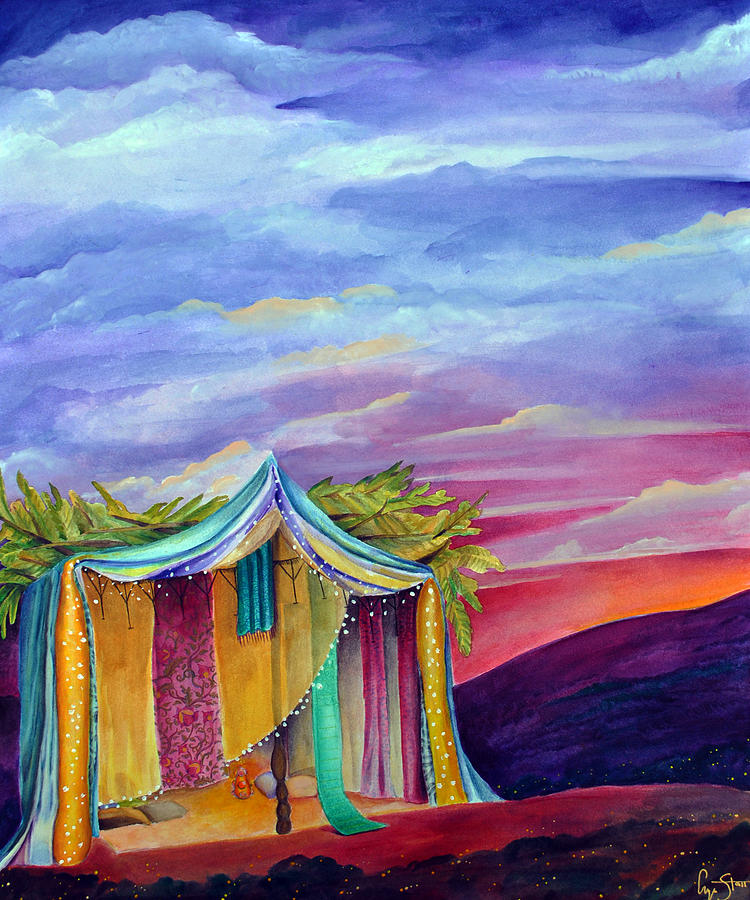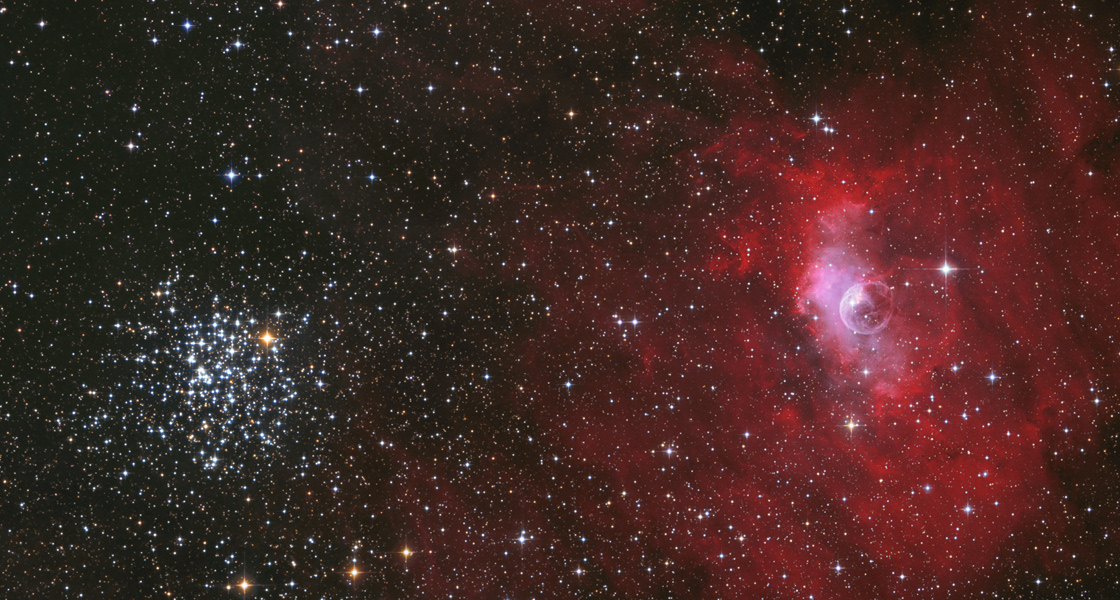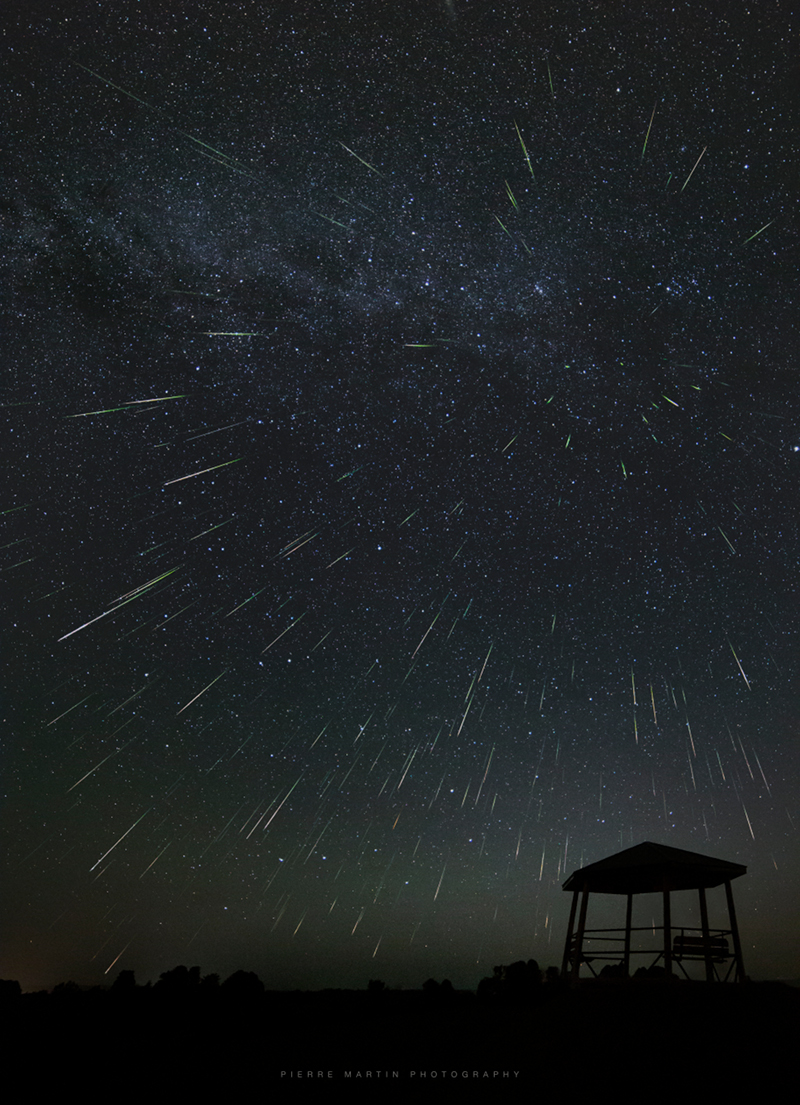Blog
The round star, known as MWC 922 and possibly part of a multiple star system, appears at the center of the Red Square Nebula. The featured image combines infrared exposures from the Hale Telescope on Mt. Palomar in California, and the Keck-2 Telescope on Mauna Kea in Hawaii. A leading progenitor hypothesis for the square nebula is that the central star or stars somehow expelled cones of gas during a late developmental stage. For MWC 922, these cones happen to incorporate nearly right angles and be visible from the sides. Supporting evidence for the conehypothesis includes radial spokes in the image that might run along the cone walls. Researchers speculate that the cones viewed from another angle would appear similar to the gigantic rings of supernova 1987A, possibly indicating that a star in MWC 922 might one day itself explode in a similar supernova.

Sukkot is celebrated by, first of all, building a sukkah. Jews are required to eat in the sukkah for eight days (seven days in Israel), and some even sleep in the sukkah for the duration of the holiday. The sukkah is decorated and the first day is considered a holy day in which most forms of work are forbidden. The rabbis dictated that arbat ha’minim (four species) should be held together and waved during the holiday. These are based on four plants mentioned in the Bible, and the rabbinic version includes the following: etrog (fruit of the citron tree), lulav (palm frond), hadas (leaves from the myrtle tree), and aravah (leaves from the willow tree). This waving ceremony was performed at the Temple in the ancient world.
The seventh day of Sukkot is called Hoshanah Rabah. On that day in the synagogue Jews circle the room seven times while the arbat ha’minim are held and special prayers are recited.

Trio Kabob with Dawn Doering, Kim Salisbury and mick laBriola will perform for a Sukkot celebration at Mt Zion Temple in St Paul on Sunday September 26th from noon-2pm. Performing a Sephardic, Arabic, Turkish and Bulgarian repertoire.
more...Victor Edward Jurusz Jr. (September 26, 1953 – December 31, 2019), known professionally as Vic Juris, was an American jazz guitarist.
Juris was born in Jersey City, New Jersey, but he moved with his family to Parsippany early in his life. In 1963, at the age of 10, he began learning guitar. At 11, he studied guitar at the home of his teacher, Ed Berg, and got interested in jazz listening to Berg’s records of guitarists Django Reinhardt, Jim Hall, Barney Kessel, Jimmy Raney, and Johnny Smith. When asked about albums that made an impact on him as a kid, Juris cites Rubber Soul by The Beatles, The Dynamic Duo by Wes Montgomery and Jimmy Smith, Larry Coryell‘s debut album, and Are You Experienced by Jimi Hendrix. In his teens he played the rock music of the 1960s. When he was 19, he met blind saxophonist Eric Kloss and they became friends.[2] He made his first recording on Kloss’s album Bodies’ Warmth (Muse, 1975). Around the same time, he met guitarist Pat Martino, who became a friend and mentor.
https://www.youtube.com/watch?v=11sWjhqE_ko
more...Romano Mussolini (26 September 1927 – 3 February 2006) was an Italian jazz pianist, painter and film producer. He was the fourth and youngest son of Benito Mussolini, who was the fascist dictator of Italy from 1925 until 1943.
A native of Villa Carpena, Forlì (Emilia-Romagna), Romano Mussolini studied music as a child, playing classical pieces with his father on the violin.
After World War II, he started playing jazz under the assumed name “Romano Full” and by the mid-1950s, he had formed a trio. Mussolini released a self-titled record (featuring Lilian Terry on vocals and trumpeter Nunzio Rotondo) through RCA Records in 1956. By the 1960s, he had formed the “Romano Mussolini All Stars”, which became one of Italy’s foremost jazz bands.[citation needed]
The All Stars recorded a well-received record Jazz Allo Studio 7 in 1963 with At the Santa Tecla following a year later. Mussolini’s band toured internationally with artists including Dizzy Gillespie, Duke Ellington, Helen Merrill and Chet Baker. In the 1990s, Mussolini recorded two more albums, Perfect Alibi and Soft and Swing.
more...George Gershwin (/ˈɡɜːrʃ.wɪn/; born Jacob Gershwine; September 26, 1898 – July 11, 1937 Brooklyn, NY) was an American composer and pianist, whose compositions spanned both popular and classical genres. Among his best-known works are the orchestral compositions Rhapsody in Blue (1924) and An American in Paris (1928), the songs “Swanee” (1919) and “Fascinating Rhythm” (1924), the jazz standards “Embraceable You” (1928) and “I Got Rhythm” (1930), and the opera Porgy and Bess (1935), which included the hit “Summertime“.
Gershwin studied piano under Charles Hambitzer and composition with Rubin Goldmark, Henry Cowell, and Joseph Brody. He began his career as a song plugger but soon started composing Broadway theater works with his brother Ira Gershwin and with Buddy DeSylva. He moved to Paris intending to study with Nadia Boulanger, but she refused him, afraid that rigorous classical study would ruin his jazz-influenced style. He subsequently composed An American in Paris, returned to New York City and wrote Porgy and Bess with Ira and DuBose Heyward. Initially a commercial failure, it came to be considered one of the most important American operas of the twentieth century and an American cultural classic.
Gershwin moved to Hollywood and composed numerous film scores. He died in 1937 of a malignant brain tumor. His compositions have been adapted for use in film and television, with several becoming jazz standards recorded and covered in many variations.
more...The Bubble Nebula at the right with open star cluster M52. The pair would be lopsided on other scales, though. Embedded in a complex of interstellar dust and gas and blown by the winds from a single, massive O-type star, the Bubble Nebula, also known as NGC 7635, is a mere 10 light-years wide. On the other hand, M52 is a rich open cluster of around a thousand stars. The cluster is about 25 light-years across. Seen toward the northern boundary of Cassiopeia, distance estimates for the Bubble Nebula and associated cloud complex are around 11,000 light-years, while star cluster M52 lies nearly 5,000 light-years away. The wide telescopic field of view spans about 1.5 degrees on the sky or three times the apparent size of a full Moon.

John Taylor (25 September 1942 – 17 July 2015) was a British jazz pianist, born in Manchester, England, who occasionally performed on the organ and the synthesizer.
John Taylor was a self-taught pianist. With his family, he moved from Manchester, first to the Midlands and then to Hastings where he played locally. In 1964, Taylor became a civil servant, moved to London and became involved in the free jazz scene.
more...Erik Darling (September 25, 1933 – August 3, 2008) was an American songwriter and a folk music artist. He was an important influence on the folk scene in the late 1950s and early 1960s.
Darling was born in Baltimore, Maryland, United States. Inspired by the folk music group The Weavers, in the 1950s, he formed The Tunetellers, which evolved into The Tarriers with actor/singer Alan Arkin. Their version of the “Banana Boat Song” reached No. 4 on the Billboard chart.
In April 1958, Darling replaced Pete Seeger in The Weavers, and he continued working club dates with The Tarriers until November 1959. Darling also recorded three solo albums. His second solo effort, True Religion, for Vanguard in 1961 was influential on younger folkies of the day. In 1956, he accompanied the Kossoy Sisters on their album Bowling Green. Additional instrumental work is featured on Banjo Music of the Southern Appalachians (Olympic Records, undated, with Darling’s first name misspelled as Eric on the album cover). Darling left the Weavers in June 1962 to work as a soloist, on the emerging coffeehouse circuit. That summer he formed the jazz-folk trio The Rooftop Singers with longtime friend Bill Svanoe and jazz singer Lynn Taylor. Intended as a studio-only project for Vanguard, the group landed an unexpected number one pop hit with a cover of Gus Cannon‘s 1929 song “Walk Right In“. Don McLean, who became friends with Darling in 1961, looked back on Darling as “a genuine philosopher and perfectionist.” He said “I appreciated the time he spent with me so long ago. Undivided mental attention to every aspect of music making and performing is a hallmark of Erik’s work, and I believe some of that rubbed off on me.”
In 1967, Darling and Paul Bennett were co-credited for writing the song “Babe I’m Gonna Leave You,” by Quicksilver Messenger Service, which appears to be a medley of Darling’s 1958 song “St. John’s River” and Joan Baez’s recording of “Babe I’m Gonna Leave You“, originally written by Anne Bredon. He died in Chapel Hill, North Carolina, from Burkitt’s lymphoma at the age of 74.
more...Samuel Carthorne Rivers (September 25, 1923 – December 26, 2011) was an American jazz musician and composer. He performed on soprano and tenor saxophones, bass clarinet, flute, harmonica and piano.
Active in jazz since the early 1950s, he earned wider attention during the mid-1960s spread of free jazz. With a thorough command of music theory, orchestration and composition, Rivers was an influential and prominent artist in jazz music.
Rivers was born in El Reno, Oklahoma, United States. His father was a gospel musician who had sung with the Fisk Jubilee Singers and the Silverstone Quartet, exposing Rivers to music from an early age. His grandfather was Marshall W. Taylor, a religious leader from Kentucky. Rivers was stationed in California in the 1940s during a stint in the Navy. Here he performed semi-regularly with blues singer Jimmy Witherspoon. Rivers moved to Boston, Massachusetts in 1947, where he studied at the Boston Conservatory with Alan Hovhaness.
He performed with Quincy Jones, Herb Pomeroy, Tadd Dameron and others.
more...Dmitri Dmitriyevich Shostakovich (25 September [O.S. 12 September] 1906 – 9 August 1975) was a Soviet composer and pianist. He is regarded as one of the major composers of the 20th century, with a unique harmonic language and a historic importance due to his years of work under Stalin.
Shostakovich achieved fame in the Soviet Union under the patronage of the Soviet chief of staff Mikhail Tukhachevsky, but later had a complex and difficult relationship with the government. Nevertheless, he received accolades and state awards and served in the Supreme Soviet of the RSFSR (1947) and the Supreme Soviet of the Soviet Union (from 1962 until his death).
A polystylist, Shostakovich developed a hybrid voice, combining a variety of different musical techniques into his works. His music is characterized by sharp contrasts, elements of the grotesque, and ambivalent tonality; he was also heavily influenced by the neoclassical style pioneered by Igor Stravinsky, and (especially in his symphonies) by the late Romanticism of Gustav Mahler.
Shostakovich’s orchestral works include 15 symphonies and six concerti. His chamber output includes 15 string quartets, a piano quintet, two piano trios, and two pieces for string octet. His solo piano works include two sonatas, an early set of preludes, and a later set of 24 preludes and fugues. Other works include three operas, several song cycles, ballets, and a substantial quantity of film music; especially well known is the “Waltz No. 2” from the Suite for Variety Orchestra, as well as the suite of music extracted from The Gadfly.
more...The reliable meteor shower’s peak was predicted for the night of August 12/13. But persistent visual observers in North America were deluged with a startling Perseid shower outburst a day later, with reports of multiple meteors per minute and sometimes per second in the early hours of August 14. The shower radiant is high in a dark night sky in this composite image. It painstakingly registers the trails of 282 Perseids captured during the stunning outburst activity between 0650 UT (02:50am EDT) and 0900 UT (05:00am EDT) on August 14 from Westmeath Lookout, Ontario. Of course the annual Perseid meteor shower is associated with planet Earth’s passage through dusty debris from periodic comet 109P/Swift-Tuttle. The 2021 outburst could have been caused by an unanticipated encounter with the Perseid Filament, a denser ribbon of dust inside the broader debris zone.

Wayne Maurice Henderson (September 24, 1939 – April 5, 2014) was an American soul jazz and hard bop trombonist and record producer. In 1961, he co-founded the soul jazz/hard bop group The Jazz Crusaders. Henderson left the group (who by then had changed their name to The Crusaders) in 1976 to pursue a career in producing, but revived The Jazz Crusaders in 1995.
In 2007, Henderson took a position with the California College of Music in Pasadena, California.
Henderson had suffered from diabetes and died of heart failure at a Culver City hospital on April 5, 2014 at age 74.
more...Theodore “Fats” Navarro (September 24, 1923 – July 6, 1950) was an American jazz trumpet player. He was a pioneer of the bebop style of jazz improvisation in the 1940s. He had a strong stylistic influence on many other players, including Clifford Brown.
Navarro was born in Key West, Florida, of Cuban, African, and Chinese descent. He began playing piano at age six, but did not become serious about music until he began playing trumpet at the age of thirteen. He was a childhood friend of drummer Al Dreares. By the time he graduated from Douglass High School, he wanted to be away from Key West and joined a dance band headed for the Midwest.
Navarro died of tuberculosis and heroin addiction in New York City on July 6, 1950, and was survived by wife Rena (née Clark, 1927–1975) and his daughter Linda (1949-2014). He was buried in an unmarked grave, number 414, at the Rose Hill Cemetery in Linden, New Jersey.
In 1982, Navarro was inducted into the DownBeat Hall of Fame.
more...Lemon Henry “Blind Lemon” Jefferson (September 24, 1893 – December 19, 1929) was an American blues and gospel singer-songwriter and musician. He was one of the most popular blues singers of the 1920s and has been called the “Father of the Texas Blues“.
Due mainly to his high-pitched voice and the originality of his guitar playing, Jefferson’s performances were distinctive. His recordings sold well, but he was not a strong influence on younger blues singers of his generation, who could not imitate him as easily as they could other commercially successful artists. Later blues and rock and roll musicians, however, did attempt to imitate both his songs and his musical style.
Jefferson was born blind, near Coutchman, Texas. He was the youngest of seven (or possibly eight) children born to Alex and Clarissa Jefferson, who were African-American sharecroppers. Disputes regarding the date of his birth derive from contradictory census records and draft registration records. By 1900, the family was farming southeast of Streetman, Texas. Jefferson’s birth date was recorded as September 1893 in the 1900 census. The 1910 census, taken in May, before his birthday, confirms his year of birth as 1893 and indicated that the family was farming northwest of Wortham, near his birthplace.
https://www.youtube.com/watch?v=WXsxqBhmlFg
more...The rumba originated in Cuba and is a popular Latin American dance floor style, which has sexy and suggestive hip and body movements.
In their original Cuban form they had difficult and complicated rhythms, but by the time they reached Europe, a more simple style had developed. In the 1950s it was adopted by the gypsies, becoming the rumba gitana, which retained all the sensuality and charm of the gypsies. Later, in the 1970s Paco de Lucía and Cameron de la Isla transformed this style, which created an opening for hoards of flamenco fusion groups, such as the Gypsy Kings, who based there fusion on the rumba.
The first flamenco artist to record the rumba was La Niña de los Peines, and one of the best performers of the rumbawas the singer / guitarist Manzanita, although today it is the jerezano singer Capullo de Jerez who excels with his extremely exciting styles of rumbas
more...More Posts
- Billie Holiday
- Amadou Bagayoko Memorial
- Daily Roots Burning Spear
- Penguin Tariff
- Ram Dass
- Happy Birthday Carson
- Somali Blues with J.D. Steele
- Cosmo M81 M82
- Beverly Watkins
- Randy Weston
- John Pizzarelli
- Charlie Rouse
- Art Taylor
- World Music Maandeeq
- Daily Roots-Roots International
- National Protest Today
- WOW
- The Big Lie
- Somali Blues 4-6-2025
- Dangerous Nazi Take Down